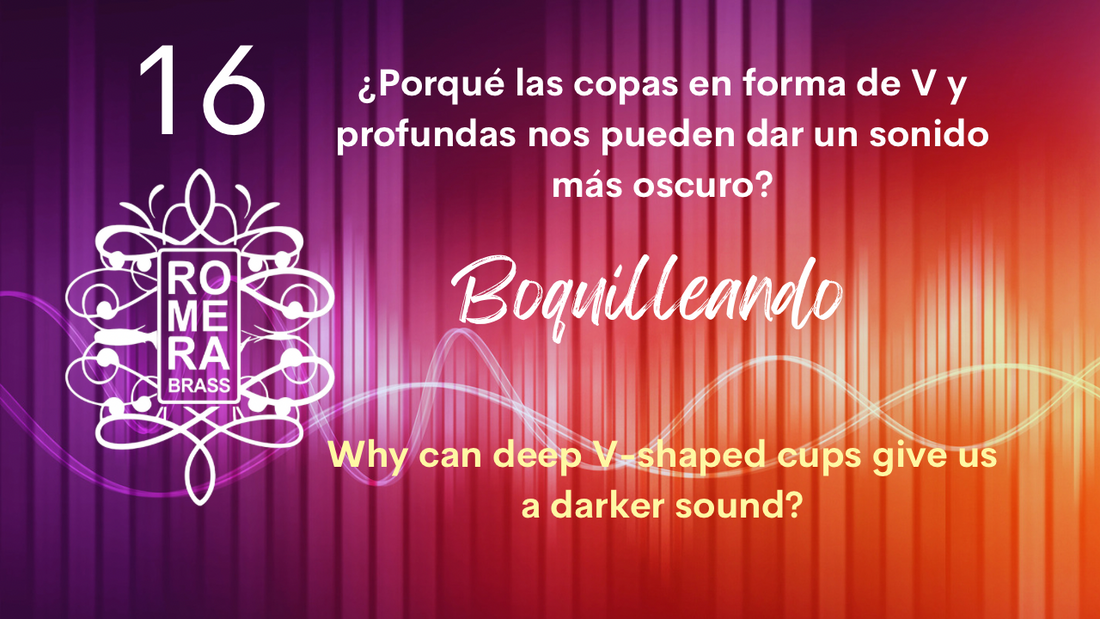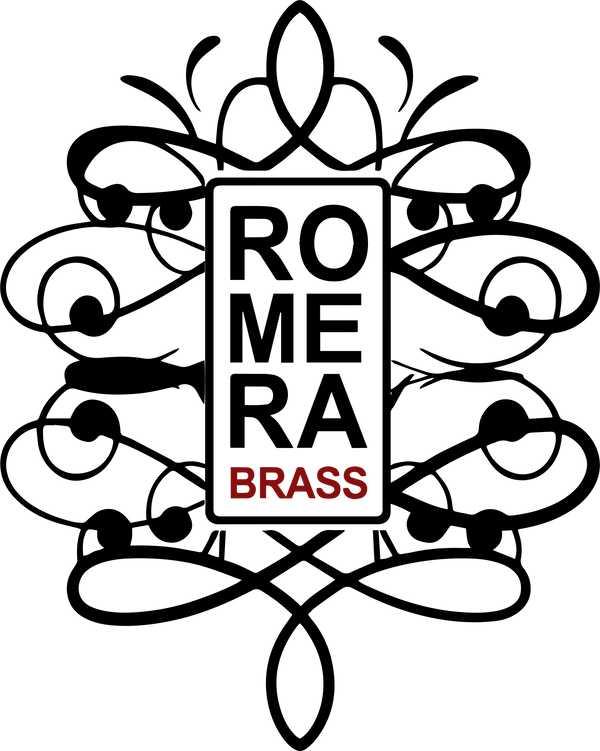
16. Why can deep V-shaped cups give us a darker sound?
Share
Link to the video of Boquilleando Nº 16 YouTube
NOTE: Transcription of the text of the video, you can translate it into other languages with the Google translator
>Hello BRASS family
In this new video Nº 16 of boquilleando we analyse a question asked by a musician.
>Why does a deep and V-shaped cup usually have a darker sound?
In this case,the musician plays the horn, but the explanation I am going to give is valid for all instruments not only for the horn players.
The musician who asked me the question plays with a fairly deep cup model R24 24mm deep and a throat of 4,5mm and without consulting me! he bought a cup from my V horn series, the V24 model, which has the same depth and throat as the model R24 but with the cup totally conical like a funnel, thinking it would have a brighter sound. If you think about it, a V-shaped cup has less volume of air inside the cup the initial part of the cup is more closed, and we may think that the sound will be brighter, in a way it would make sense, but let's see what really happens.
In this video we analyse the sound of the deep, V-shaped cups and why they can give us a darker sound and we'll have a second part which will be in another video where we will analyse the shallower V-shaped cups since they behave in a very different way and these can give us a brighter sound.
Let’s start!!!!!
The truth is that the deep V-shaped cups would not have this darker sound but we introduce another element that will be decisive and this element is the throat.
All mouthpieces manufacturers normally make the mouthpieces in the same way, the deeper the cup is, the larger the throat is. and this is the key point so that the sound in this type of V-shaped mouthpiece, deep cup and large throat can give us a darker sound.
You can go to any mouthpieces catalogue of any brand and you will be able to check it, the deeper the cups are, the wider the throat is.
But let's get to subject To try to explain why this happens, I will make a comparison with this cup of my horn R series which has some curves inside. And on the other side we have a totally conical V-cup with the same cup depth and throat.
As we saw in the video of boquilleando Nº 7 if you haven't seen it yet, don't miss it, I will explain among other things, that the basic function of the mouthpiece is to regulate the pressure, speed and retention of the air that is created inside it, well In a way we will talk about the same thing here, pressures, speed and air retention that depending on the shape of the cup can vary
Now to continue the explanation we need another element which is an acoustic phenomenon, which is called "Sound reflection".
Sound waves produced by the vibration of the lip pass through the inside of the mouthpiece towards the instrument and these waves are the musical notes, so when we play a mouthpiece with some curves in its interior as this model, the sound waves already find some first obstacles in the shape of the cup and occurs the phenomenon sound reflection.
Well, I'm sure you don't understand what I am talking about, I have told you about the V-cups that a large throat is decisive, of sound waves, of sound reflection, but let's go a little bit deeper and you will see how in the end I think that everything will fit together
I try to explain in a simple way the phenomenon of sound reflection.
When we touch the vibration of the lip, it produces sound waves, and depending on the shape of the cup these waves can be altered and change direction.
Some of these waves can bounce back to us in the middle of the cup and change direction, others can go all the way to the throat, some of them can be reflected in the middle of the cup, others further down. will depend, as I said, on the shape of the cup,
somehow inside the mouthpiece there is an anarchy of waves, some go down, some go up, some are reflected, others are not.
In reality it is a chaos what I have tried to reflect in this drawing, but within this chaos, there is a certain order, so many bounces and and crossed waves give us a sound richer in harmonics and the more harmonics the more beatiful the sound is and with more life and more sparkle.
Remember that I'm exaggerating a little bit but it is to get a good understanding of the phenomenon of sound reflection. Now let's see what happens with a V-shaped cup. V-cups have the inner shape like a wide funnel from the top and then tapers down to the final part of the cup, which is the throat, the walls are conical without the curves we have seen in the previous cup.
This means that the sound waves do not reflect as much and basically they don't start reflecting until they reach the end of the cup where the throat is located. But remember that before I talked about the throat, that normally the deep cups also have a larger throat and this is the main reason that the sound is usually darker in this type of V and deep cups.
And here is the answer to the question Why can deep, V-shaped cups give us a darker sound? First of all, in the V-cups the sound waves find less interference to bounce off the walls of the cup, and secondly, because of the wide throat, many of the sound waves go directly into the instrument,
and somehow they have not had time to reflect and enrich themselves as we have seen with the cups with curves on the inside with these two characteristic V-cup and large throat somehow we hear a sound as if it were poorer in harmonics and our feeling is that the sound is darker.
🙏I beg your pardon for a so boring talk for such a simple explanatori😅
And now, I know what's going through your minds, we put in a smaller throat and that's it, it sounds brighter but here's the bad news, this doesn't work either,
Other consequences in this type of deep V-shaped cups and large throat. The stacatto is normally more difficult to centre and a bit dirtier. It is exactly for the same reason. There is a lot of distance until the sound is reflected. The reflection of the sound is vital to have a good stacatto, I try to explain in a simple way the phenomenon of sound reflection.
I can see that with this V-cup issue, we'll have to make more chapters. Work is piling up, well there's no hurry we will continue explaining more things, what I know and what I am learning along the way.
Today we have analysed why deep V-shaped cups often have a darker sound It's been a while since I've made a boquilleando video, the truth is that I have prioritised finishing my my new website, which has taken me a lot of work and the boquilleando videos have remained a little stopped.
Take a look at the new website and let me know what you think about it
So far today's video I look forward to your questions and comments
Greetings and lots of music
